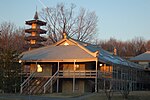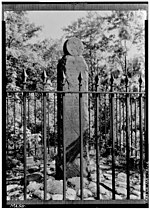John Cole Farm
1770 establishments in Rhode IslandFarms on the National Register of Historic Places in Rhode IslandHouses completed in 1770Houses in Cumberland, Rhode IslandNational Register of Historic Places in Providence County, Rhode Island ... and 1 more
Providence County, Rhode Island Registered Historic Place stubs

The John Cole Farm (also known as Intervale Farm) is an historic colonial farm on Reservoir Road in the far northeast of Cumberland, Rhode Island. The main farmhouse, a 1+1⁄2-story Cape style wood-frame structure, was built c. 1770 by John Cole not long after his acquisition of the property. The property, including a half-dozen outbuildings, has had only minimal intrusion of modern 20th-century amenities, and is a well-kept example of vernacular rural architecture of the late 18th century.The farm was listed on the National Register of Historic Places in 1977.
Excerpt from the Wikipedia article John Cole Farm (License: CC BY-SA 3.0, Authors, Images).John Cole Farm
Reservoir Road,
Geographical coordinates (GPS) Address Nearby Places Show on map
Geographical coordinates (GPS)
| Latitude | Longitude |
|---|---|
| N 41.990555555556 ° | E -71.406666666667 ° |
Address
Reservoir Road 44
02864
Rhode Island, United States
Open on Google Maps








